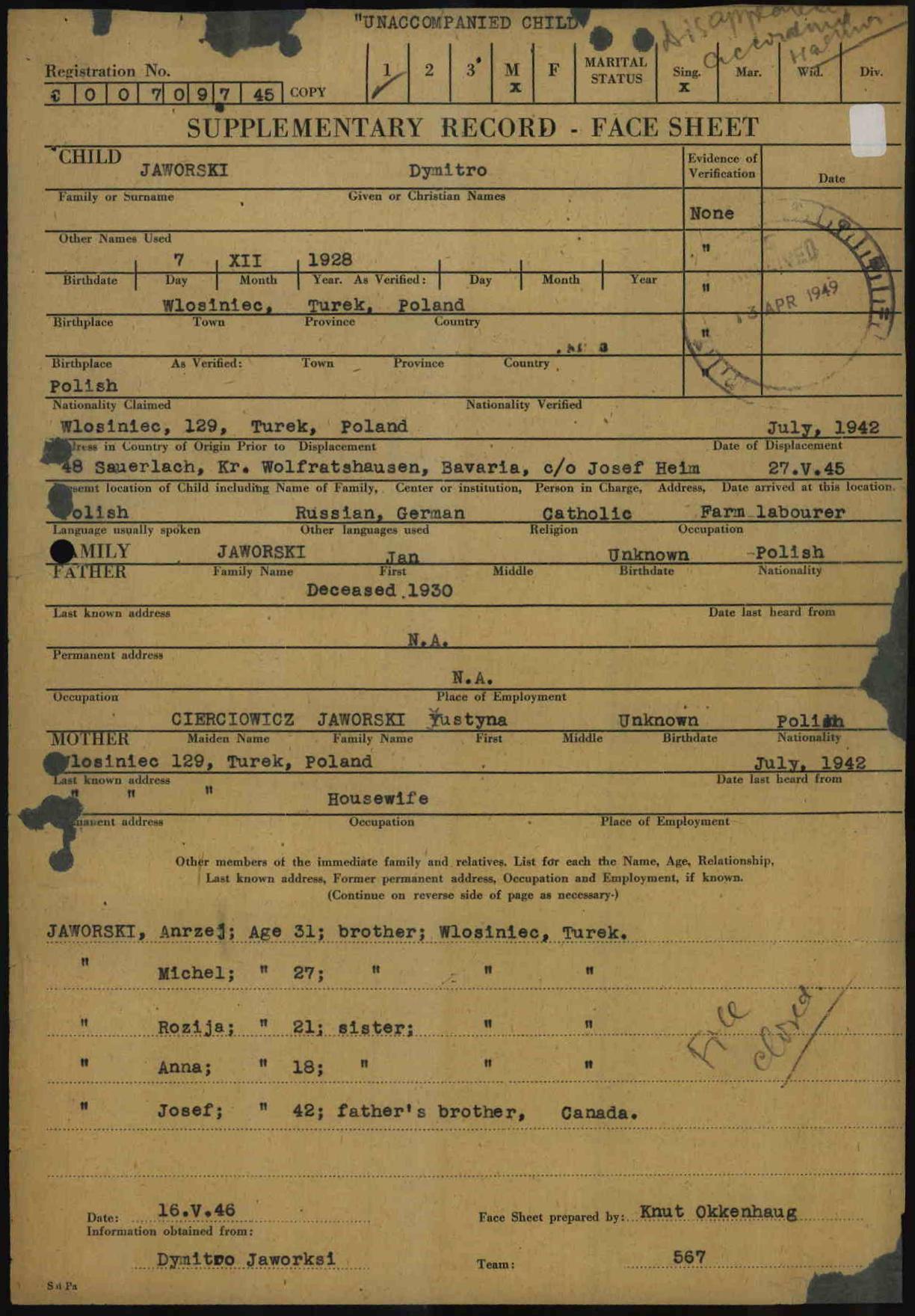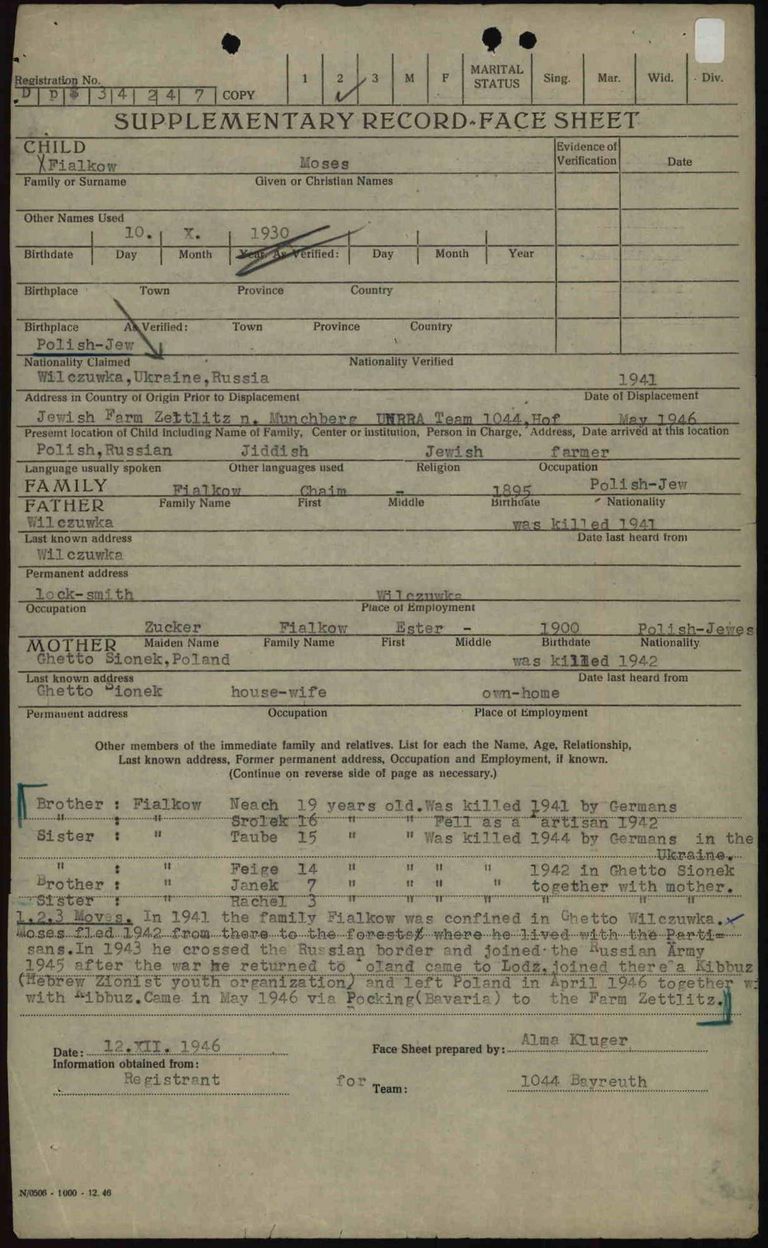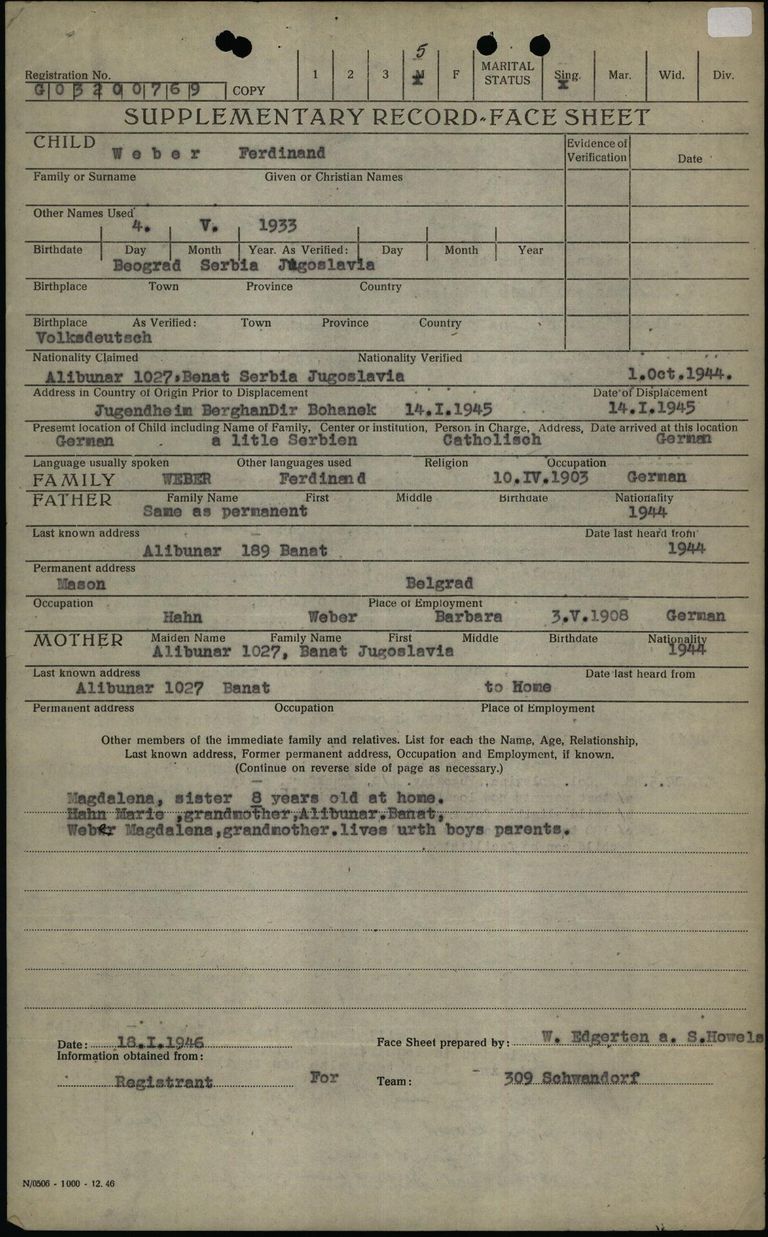Page of
Page/
- Reference
- Intro


In the DP camps in the British and US zones, UNRRA and later IRO employees used these supplementary records for people who, due to their age or health, could not provide precise information about themselves when they were registered. This was especially the case for unaccompanied children who had been found without their parents or other relatives after the war. With the help of the information on the supplementary record, employees of the Child Tracing Branch attempted to identify the children and find their family members.
In the DP camps in the British and US zones, UNRRA and later IRO employees used these supplementary records for people who, due to their age or health, could not provide precise information about themselves when they were registered. This was especially the case for unaccompanied children who had been found without their parents or other relatives after the war. With the help of the information on the supplementary record, employees of the Child Tracing Branch attempted to identify the children and find their family members.
Questions and answers
-
Where was the document used and who created it?
One of the most important steps when DPs were first registered in a DP camp in the British or US zone was the completion of a DP 2 card. The DPs gave their personal information to registrars who wrote the data on the cards. However, some people could not provide any detailed information about themselves because they were too young or too ill, for example. This included many children who had been found without their parents. For these people, UNRRA and later IRO employees filled out a supplementary sheet which was subsequently used to try to identify them and find their relatives. Since this sheet was used together with the DP 2 card, it was officially known as the supplementary record and had the abbreviation DP 2/1 or DP 2-A.
According to the instructions that had been issued, the supplementary record was supposed to be filled out in duplicate. The original was initially kept with the DP 2 card in the camp; if the DPs moved to a different camp, they took the supplementary record with them. The duplicate was forwarded to the responsible tracing office so that the search for relatives could begin. For unaccompanied children who had been found on their own, the records followed two different routes. The original was sent with the children to special children’s homes that had been set up by UNRRA and later the IRO in Rohlstorf and Bad Aibling, for example. Under certain circumstances, the record and associated file could even leave the country with the child if he or she emigrated. The second record was initially sent to the Child Tracing Section of the Central Tracing Bureau (CTB). The name of this office changed over the years, until finally the Child Search Branch of the International Tracing Service (ITS) became responsible for tracing children. By the summer of 1948 at the latest – at least in the US zone – the supplementary records were filled out in triplicate. The third copy was sent to the respective IRO Area Child Care Officer. Depending on where the record was sent, it would be used by various UNRRA and IRO employees. They updated the records and added new information about the children as well as the steps that had been taken to search for relatives.
- When was the document used?
The authorities began registering DPs with DP 2 cards immediately after the liberation of the countries formerly occupied by the Nazis. However, there is no mention of the supplementary record in the earliest instructions from June 1944, which precisely outlined the registration process using DP 1, DP 2 and DP 3 cards. The supplementary records apparently emerged somewhat later, when the search for children and adolescents intensified from September 1945 in the British and US zones. Instructions from October 1945 are the first to describe how the supplementary record was to be filled out.
After the IRO ended its active tracing operations in 1951, no new supplementary records were created. However, the files in which the records were placed continued to be used. To this day, the child search files are used by employees of the Arolsen Archives to respond to inquiries. One fate is also portrayed in the exhibition “A Paper Monument”.
- What was the document used for?
The purpose of this document is clear from its official title: “Supplementary record for identifying and tracing special categories of displaced persons.” The records were supposed to be used for the registration of people who could not provide any reliable information about themselves. These people included survivors of Nazi persecution who, due to their age or their physical or mental state, could not say who they were.
This particularly applied to unaccompanied children, meaning young people under the age of 18 or 16 whom the Allies had found without their birth parents. Many of them had been deported by the Nazis to Germany and the occupied territories to perform forced labor. 1.5 million of all forced laborers were under the age of 18. Another large group of unaccompanied children were those who had been taken from their families by the Nazis in order to be given up for adoption in Germany. This so-called “Germanization” affected tens of thousands of children especially from the Baltic states and Poland, but also from Russia, the Netherlands and Yugoslavia. To this day, the exact number of these children is not known because the Nazis tried to destroy the evidence about them on a large scale. It is therefore estimated that the number of unidentified victims of Germanization is very high. From the summer of 1945, UNRRA searched specifically for these “stolen children” in German families and homes so that they could be returned to their birth parents. The term unaccompanied children was also applied to children who were born in DP camps after the end of the war, whose parents had then died or were unable or unwilling to care for them for various reasons. The latter was often the case if the children were the result of an extramarital relationship or the parents, after years of persecution, were either ill or simply overwhelmed by the prospect of caring for a child. Additionally, there were some Jewish children and adolescents – though very few – who had survived the Holocaust in hiding or in a concentration camp. Special children’s centers with kindergartens and schools were set up to care for the unaccompanied children, identify them and prepare them to return home. In many instances, however, no relatives could be found. In this case, young children would be sent to homes in their country of origin, while children aged 16 or older were supposed to decide for themselves whether they wanted to return or emigrate.
To start the search for relatives, UNRRA and later IRO employees had to complete a supplementary record for each child. According to the precise instructions that had been issued, they were supposed to immediately fill out the child’s DP 2 card, but they could take time with the supplementary record in order to build up a trusting relationship with the children and adolescents. They were supposed to observe the children during everyday activities such as eating lunch or playing to see whether they sang any songs or engaged in any other behavior that might hint at which country they came from. The officials who drew up the instructions were aware that young children would no longer remember their past and older adolescents might refuse to reveal information about their families on account of their experiences of persecution. All of the information gathered through interviews with the children and through observation was noted by UNRRA and later IRO employees on the supplementary records. The employees were required to write down everything, even if it seemed unimportant at first.
The employees of the Child Tracing Section of the Central Tracing Bureau – and then the responsible authorities in the individual occupation zones from February 1947 onward – created both a card for the master index or child search index and a file with the supplementary record. On the record, they noted the additional steps taken to search for relatives. From April 1948, employees of the re-centralized Child Search Branch of the ITS in Esslingen used the files. After the active search was brought to an end, the supplementary records and files were handed over to the newly established Child Tracing Branch or Child Tracing Section of the ITS in Arolsen. To this day, they are used to respond to inquiries.
- How common is the document?
It is not known how many supplementary records are now held in the Arolsen Archives. Unfortunately, it is also not clear how many records in total were ever created. The only hint is provided by a letter from the Central Tracing Bureau, according to which 3,000 supplementary records alone were sent to UNRRA headquarters in December 1945. But there must have been far more records than this, because there were nearly 13,000 children in Germany under UNRRA supervision. In the Arolsen Archives, most of the records can be found in the files of the Child Tracing Branch (Collection 6.3.2.1). However, not all of these 65,000 files have a supplementary record in them.
- What should be considered when working with the document?
If you have any additional information about these records, we would appreciate it very much if you could send your feedback to eguide@arolsen-archives.org. New findings can always be incorporated into the e-Guide and shared with everyone.
Help for documents
About the scan of this document <br> Markings on scan <br> Questions and answers about the document <br> More sample cards <br> Variants of the document



